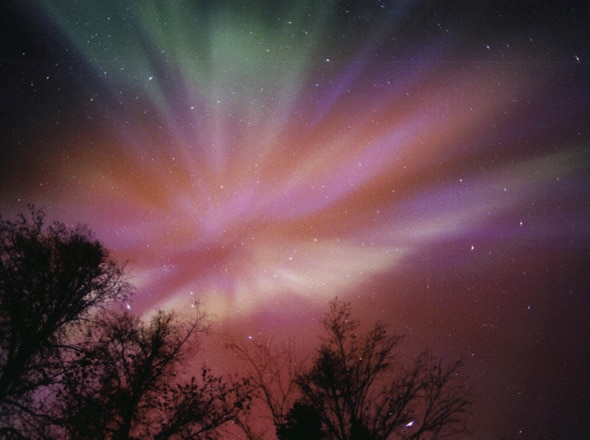Create a free profile to get unlimited access to exclusive videos, sweepstakes, and more!
INCREDIBLE Footage of An Aurora Dancing in Real Time!

There’s been a lot of aurora activity the past few months, though few big “storms” where the northern lights can be seen even at midlatitudes. But there was a warning of a possible geomagnetic storm around Valentine’s Day, so “skydivephil” flew to Iceland, hoping to capture the aurora on his camera. What he got was magical: real-time video of the lights flickering, moving, and dancing across the sky!
(You know the drill: make it hi-res, and full screen; you'll be glad you did.)
As far as I can tell, this footage is authentic. Certainly his reaction is the same one I’d have! Usually, the movement of an aurora is so slow it takes time-lapse video to reveal it, but clearly the Earth’s magnetic field was feeling feisty that night. Let me explain …
An aurora is caused by subatomic particles streaming away from the Sun. The Sun blows a wind of them all the time (the solar wind), but sometimes there can be highly enhanced bursts of them from a solar storm, like when there’s a flare or a coronal mass ejection. Both of these are huge explosions on or above the Sun’s surface, and can blast millions or even billions of tons of particles into space.
If they are aimed our way, these waves of particles can interact with the Earth. A basic principle of electromagnetism is that a moving charged particle has a magnetic field, and that’s true for a solar storm. Normally, the Earth’s magnetic field rebuffs the oncoming particles, the way two magnets can repel each other if their poles are aligned. But sometimes the oncoming wave has its poles flipped, so the particles can then stream into and along the Earth’s magnetic field.
When that happens the particles slide along the geomagnetic field a bit like beads on wires, and get fed into the Earth’s upper atmosphere. At a height of about 100 kilometers (60 miles) above the ground these high-speed particles slam into our air, exciting (giving energy to) electrons in the molecules. When the molecules settle back down, they emit light. Depending on the molecule itself (like nitrogen or oxygen) the light can be green, red, blue, purple, and sometimes even look hot pink! That’s the aurora. I’ll note that we can get aurorae from just the solar wind without a big storm from the Sun, but when there is a storm the aurora are much brighter and more active.
The shape of the aurora seen from the ground depends on the shape of the Earth’s magnetic field. It can form long ribbons or sheets which look like curtains of light in the sky, or it can just be a diffuse glow. The shape can change as the solar wind’s magnetic field interacts with the Earth’s field, and it’s usually slow and stately. But it can also happen very rapidly, as you can see in the video. Then the aurora is like a living thing, writhing and shimmering.
I’ve seen dozens of videos where it takes several minutes for the aurora to change shape, and it wasn’t until fairly recently that I saw a real-time video of them snapping and flapping around. It’s amazing. I love the sideways slipping motion, like a vertical wave blowing across the sky (it kinda reminds me of Tinkerbell spreading pixie dust in the Disney animations, actually), the colors changing as different molecules in the air react to the subatomic onslaught.
You can hear the photographer talking about a “corona”: that’s when it looks like a crown in the sky, wrapped around the point over your head. It’s a perspective effect, because you’re looking up into a bunch of parallel sheets and ribbons of light. They seem to converge or point to a spot over your head, something like the way a road looks like it converges on the horizon. Normally, photos of aurorae show them from the side, but when you’re directly under it you can get this corona effect. skydivephil was lucky enough to be in precisely the right location to see this perfectly.
And he was even luckier than that. He went to Iceland because he heard there were going to be storms, but those storms never really materialized. According to spaceweather.com, the puffs of material from the Sun never really got their act together enough to create huge aurorae, but there was enough to create that stunning display in Iceland.
Despite some nice magnetic activity from the Sun recently, there still hasn’t been a strong enough storm to be visible as far south as my home town of Boulder (at least, not when we've had clear skies). To this day I still have not seen an actual aurora! I’m hoping my time will come, but if it doesn’t come soon I may have to wait many years; the Sun’s activity is cyclical, and may be on the way down right now. It’ll be a decade or so before we get to the next peak, and the Sun becomes stormy once again.
There are lots of ways to keep tabs on auroral activity. You can follow Aurora Alerts on Twitter and read SpaceWeather.com. You can get more technical info from the NOAA Space Weather Prediction Center, too. It’s better the farther north you are (or south, if you’re in the southern hemisphere), but a good storm can reach lower latitudes. skydivephil has a video on how to find out if there will be an aurora near you, and how to photograph it, too. Let’s hope we get some good activity and a free sky show soon!


























